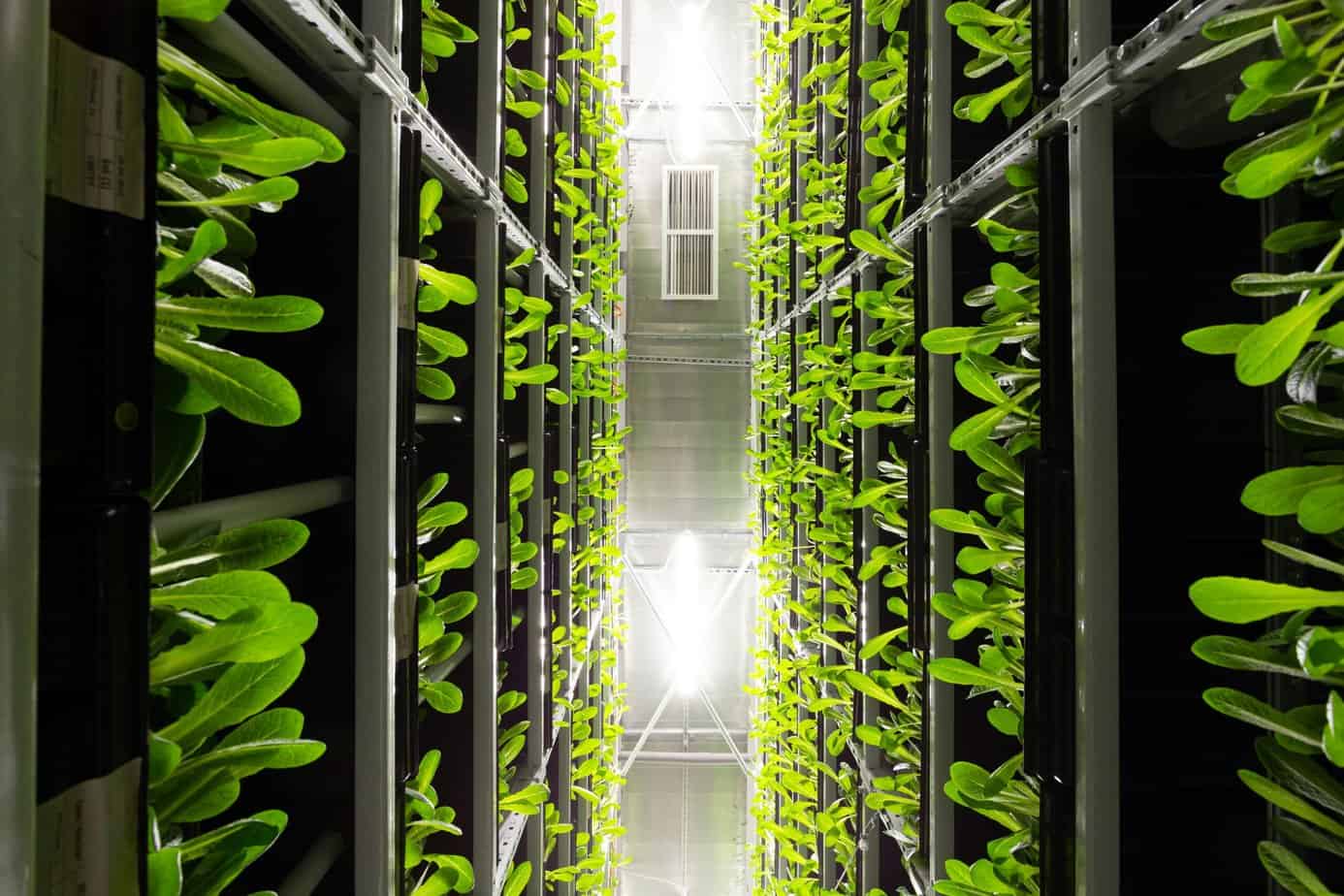Your cart is currently empty!
Urban Food Production | Vertical Farming & Innovation
Growing Food Everywhere

So today, not all farmers work the soil to produce food. Urban food production is sought after to scale agriculture in cities. Vertical and enclosed urban farms are sprouting up all across the world. One of the companies building these growing platforms, Controlled-Environments Agriculture (CEA), as the new soil acres are called, is Gotham Greens.” It has built growing systems in Brooklyn, Queens, and Chicago. Founded in 2009, Gotham Greens operates on the assumption that food production need not occur on traditional dirt farms. Its large, commercial-scale greenhouses sit atop buildings in urban landscapes and grow leafy greens using LED lights powered by solar panels.
Because they are enclosed, these urban farms are protected from pests and other environmental conditions that open-air farmers contend with every day. And Gotham Greens and other such companies want to go big. These farms produce hundreds of thousands of pounds of leafy greens, berries, and herbs for urban customers, some of which are grocery stores like Whole Foods and even, surprisingly, Walmart.
Greenhouses And Rooftop Farms
Growing plants in greenhouses isn’t all that innovative, but locating the greenhouses on rooftops in dense urban areas to shorten the “Last Mile” delivery might be an improvement. These new ventures illustrate how where we produce our food directly impacts the supply chain and food logistics. The idea certainly appeals to advocates of local food production, and any efforts to improve food production are laudable. The use of these farms to produce leafy greens and other foods that suffer in transport makes sense in terms of high-value products that will forego their large carbon footprint on the way to market. One logical use case for these farms is those regions in cold-climate zones, such as Norway, where vertical farms produce strawberries. In the Netherlands, vertical farms can overcome the lack of arable land for crop production.
One wonders, though, if Gotham Greens‘ urban rooftop gardens depend too heavily on urban rooftops —after all, there are only so many rooftops to take over, even in New York. These are all traditional methods of urban food production. The flipside of closed growing systems is the risk of contamination or invasive insects that would have a field day in one of those self-contained greenhouses. And while it would undoubtedly be a problem on a private balcony garden, in a commercial outfit like Gotham Greens, contamination would spell disaster. The risks of monocultures are not specific to corn crops in the Midwest or China.
Freight Container Farms

A contained growing environment is also the platform for Freight Farms; a venture started in 2009 by Jon Friedman and Brad McNamara that combines some of Harper’s ideas with growing food in shipping containers. Not stuck on a rooftop, shipping containers are mobile and scalable as long as there’s room to spread out or stack them up. In growing containers spread throughout the United States, Freight Farms uses hydroponic systems (water instead of soil) and LED lights to grow plants. Its sensors collect growing data that farmers can view through the Farmhand mobile app.
AeroFarms, an urban farming company founded in 2015, uses aeroponics, as one might expect from its name. Aeroponics joins a list of growing technologies that don’t rely on soil on the ground: hydroponics, aquaponics, and aeroponics. “Ponics,” from Latin, means “work.” Instead of working the soil to grow plants, these modern farmers work water and air.
Hydroponics grows plants in water using root systems to pull nutrients into the plant. Aquaponics also uses water, but it adds nutrient fertilizer from fish raised in the water. Aeroponics uses water not by immersing the root systems in water but by suspending the root systems in a humid environment where water sprays fill the air with moisture. All three of these systems are used for greenhouses and vertical farms in cities.
Located in New Jersey, the state still called the Garden State, Aerofarms produces indoor, enclosed farms that can be built inside homes, offices, warehouses, or just about anywhere else. Its growing units can be stacked or spread out, and the company is keen to use industrial spaces such as old nightclubs or paintball factories. Schools can buy their systems as educational platforms and perhaps even for food production.
Food Startups In Urban Food Production
At SXSW in 2017, a Los Angeles startup brought its farm to Austin. Called Local Roots, the company promises to produce food year-round, “undoing the commodification of the food industry” and “eliminating supply chain risks” by building a network of farms.
Using its “Terrafarm” solution, Local Roots sells its produce through restaurants in Southern California. SpaceX uses a Terrafarm to produce its greens. These innovative gardens may seem like an ideal solution, but they’re still fighting back some nasty weeds. Over the past few years, early leaders in the field, including PodPonics in Atlanta, FarmedHere in Chicago, and Local Garden in Vancouver, have shut down.
Some had design issues, while others started too early when hardware costs were much higher. Gotham Greens and AeroFarms look promising, but they haven’t raised comparable cash hoards or outlined similarly ambitious plans yet. By the time you read this, they may be installing acres of growing platforms in your city. Vertical, container and other enclosed and moveable farms are appearing faster than we imagined. This is even though few are close to profitable and crop diversity is limited.
Several Cities Involved

Once considered a novel and small-scale option for food production, these new urban farms are quickly gathering momentum. Initiatives launched in San Francisco and cities around the world are making plans. These plans are for ways to integrate food production into their master plans. In the Netherlands, an urban farm project called Fresh Care Convenience was announced in 2017 between Phillips Lighting and a large fresh food company, Staay Food Group—the construction of Europe’s first large-scale vertical farm.
Several grocery stores in Germany are adding indoor farms designed by Infarm, a startup located in Berlin. And in Texas, two indoor farm companies are setting up farms, one in Abeline and another in Lockhart. These two ventures illustrate how these projects benefit from private/public partnerships.
Both cities view the farm projects as sources of economic development and provide incentives in the form of subsidies and land. The Brightfarms project in Abilene will be the first hydroponic farm in Texas, a state known for its droughts. These ventures also enable food production in unexpected places. Places like a shrimp farm in Nebraska Rock Creek Aquaculture shorten the supply chains for seafood. This is from oceans far away and provides some local jobs. And Plenty, headquartered in South San Francisco, combines LED lighting, hydroponics, tech funders, and vertical farming to explore how to scale these ventures so that they are both environmentally and economically sustainable.
New Ventures In Urban Food Production
For now, these ventures are sticking to the leafy greens and herbs well suited to these platforms. But what happens when the market is saturated with culinary lettuce, but customers need squash, potatoes, and radishes? And will all these contained, vertical, urban farms be able to scale?
Will they produce food at prices competitive with supermarkets like Costco and Walmart, which are both significant players in organic food markets? Looks more like a reality than ever before, though if any of these ventures that depend upon scaling to be financially sustainable succeed, they will need to consider what to do with a surplus of food. Will they require transport of produce out of the city? Once they’ve brought seeds and inputs into the town to grow materials for consumers, these are friction points. This will be addressed as engineers and consumers discover whom they want as food producers. This will also include where and how they want to shop for food. None of these ventures has yet to fully calculate an ROl for the long term. Soon enough, the dried fruit, like the black raisins you eat, will have been grown from vertical farms.
Even traditional greenhouses may indeed fill a much-needed gap. This gap is in the supply chain sourcing world, especially during times of climate change. They aren’t new, but they are now full of sensors and LED lighting systems. Growing food in resource-deficient environments might be the most significant opportunity for the supply chain. All of these ventures promote the idea of farming with less water. This includes no pesticides and increased productivity over land-based farming. This would provide tighter control over the growing process and environment.
Handheld Farming

Many of these new “farms” integrate mobile devices for produce monitoring. Say you have a micro-farm in your apartment connected to sensors that send growing conditions. You might learn your lettuce needs water. If that is the case, you can send instructions to your micro-farm to adjust the micro-irrigation system. This would allow us to put the proper levels for that type of plant. Or you’re a commercial farmer, and your smartphone tells you that there is too much moisture in the field at the far end of your farm; you decide not to irrigate that day. Is this handheld farming the future? Will growers miss the grounding experience of sensing moisture with their own hands? New farmers don’t think so.
The future of such systems could get complicated once you consider what success might look like for these ventures. Imagine that Freight Farms’ containers become backyard food production. Houses can be scaled for personal food, with enough produce year-round to feed a family or city block. Would that eliminate the trips to the grocery store? Solve for food deserts? Or will the novelty of these solutions dissipate, leaving behind only the routine of tending to one’s garden?
Some of the most exciting startups are growing food in new places. These are places such as shipping containers. We are also intrigued by the idea of producing our own food at home, even in our own kitchens. Several startups, such as SproutsIO, are offering personal growing systems. These fit in a condo or home kitchen with the ingredients for growing herbs, greens, and even tomatoes. Using technology similar to that of vertical farms, these new systems offer apps so you can monitor the moisture.
Blog assisted by rzwilliams.com







